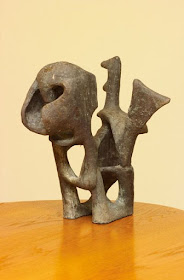"Lotti van der Gaag was born as Charlotte van der Gaag on the 18th of December 1923 in The Hague. She was an active sculptor and painter. Lotti was at the Haagse Vrije Academie (The Free Academy of the Hague) with Livinus van de Bundt till 1949 and she almost entirely devoted herself to sculpturing.* Next to sculpturing and painting, she always continued to draft drawings. She never officially became a member of the CoBrA movement, but because of her affiliation with CoBrA’s art she was considered as part of the ‘experimentals’ and she exposed her works beside them. She shared the same atelier building with Karel Appel (1921-2006) and Corneille (1922-2010) in Paris. In 1948, before she even knew the artworks of CoBrA, she began to sculpt in a spontaneous manner strange and often constricting fantasy creatures in clay. Especially her reliefs in terra cotta, with which she made her debut in 1949, and her drawings translated through the utilization of a primitivistic impact of the subjects that surround the CoBrA myth.* The oeuvre of Lotti played a remarkable role in the informal, abstract-expressionistic art from after 1945, because of the emphasis on the raw matter that broke apart from its natural form and the vital expression that was exalted to become a goal on its own. Sometimes strange-like crossings arose between polyp-like forms of plants and animals, that suddenly turned out as birds of prey or forest spirits. She left for Paris at the end of 1950 where she began to make drawings.
She drew childlike fantasy creatures on paper in a very powerful manner with fat and often black lines using Siberian crayon, that often were referred to their big heads with strong emphasized eyes in her images of this period.* Under the influence of her Parisian tutor Ossip Zadkine (1890-1967) she “broke”figures open as from the end of 1950 to give a broad access to the image/sculpture.* Her plastics evolved from small compact chamotte figures to more monumental constructions. The first open work* sculptures, the “maanmannen” (moonmen), marked the startingpointo her so-called “vegetative” period in the 60’s. The clay was caught up in vegetal forms and the fantasy creatures were abstracted into a complex play of forms of rampant vegetation. In this period Lotti turned her focus to oilpaint on canvas and more or less began to create abstract, surrealistic paintings in earth tones that seamlessly made connections with the vegetative images. Lotti shoved the anecdotacal values of the imatative art aside and cleared, apart from the tradition, the way for sovereign artworks that no longer refer to reality or to nature, but that represent their own nature. Particularly as a sculptress she enjoyed as from the 50’s and 60’s a widespread reputation at home and abroad. Her sculptures, paintings and drawings were included in various museums and private collections."(cobra-museum.nl)













No comments:
Post a Comment